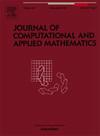High-order implicit maximum-principle-preserving local discontinuous Galerkin methods for convection–diffusion equations
IF 2.1
2区 数学
Q1 MATHEMATICS, APPLIED
Journal of Computational and Applied Mathematics
Pub Date : 2025-04-12
DOI:10.1016/j.cam.2025.116660
引用次数: 0
Abstract
We consider maximum-principle-preserving (MPP) property of two types of implicit local discontinuous Galerkin (LDG) schemes for solving diffusion and convection–diffusion equations. The first one is the original LDG scheme proposed in Cockburn and Shu (1998) with backward Euler time discretization. The second one adds an MPP scaling limiter defined in Zhang and Shu (2010), to the first one. Compared with explicit time discretization, implicit method allows for a larger time step. For pure diffusion equations in 1D, we prove that the second type of the LDG schemes is MPP, which can also achieve high order accuracy. This result can be generalized to 2D by using tensor product meshes but only for the second order case. For convection–diffusion equations, the first type of LDG schemes, in the second order case in 1D, is proved to be MPP. In all the results above, in order to achieve the MPP property, it is necessary to have a lower bound on the time step in terms of the Courant–Friedrichs–Lewy (CFL) number. Although the analysis is only performed on linear equations, numerical experiments are provided to demonstrate that the second type of the LDG schemes works well in terms of the MPP property both for nonlinear convection–diffusion equations and for 2D higher order cases.
对流扩散方程的高阶隐式保极大原理局部不连续Galerkin方法
研究了求解扩散方程和对流扩散方程的两类隐式局部不连续伽辽金格式的最大保原理(MPP)性质。第一种是Cockburn和Shu(1998)提出的原始LDG方案,采用了向后欧拉时间离散化。第二个模型在第一个模型的基础上增加了张和舒(2010)定义的MPP缩放限制器。与显式时间离散相比,隐式方法允许更大的时间步长。对于一维的纯扩散方程,我们证明了第二类LDG格式是MPP格式,它也能达到较高的阶精度。这个结果可以用张量积网格推广到二维,但只适用于二阶Q1情况。对于对流扩散方程,证明了一维中二阶P1情况下的第一类LDG格式是MPP。在上述所有结果中,为了实现MPP性质,需要在时间步长上有一个关于Courant-Friedrichs-Lewy (CFL)数的下界。虽然分析只在线性方程上进行,但提供了数值实验来证明第二类LDG格式在非线性对流扩散方程和二维高阶情况下的MPP特性方面都很好。
本文章由计算机程序翻译,如有差异,请以英文原文为准。
求助全文
约1分钟内获得全文
求助全文
来源期刊
CiteScore
5.40
自引率
4.20%
发文量
437
审稿时长
3.0 months
期刊介绍:
The Journal of Computational and Applied Mathematics publishes original papers of high scientific value in all areas of computational and applied mathematics. The main interest of the Journal is in papers that describe and analyze new computational techniques for solving scientific or engineering problems. Also the improved analysis, including the effectiveness and applicability, of existing methods and algorithms is of importance. The computational efficiency (e.g. the convergence, stability, accuracy, ...) should be proved and illustrated by nontrivial numerical examples. Papers describing only variants of existing methods, without adding significant new computational properties are not of interest.
The audience consists of: applied mathematicians, numerical analysts, computational scientists and engineers.

 求助内容:
求助内容: 应助结果提醒方式:
应助结果提醒方式:


